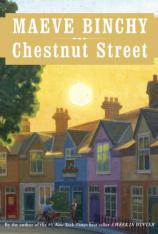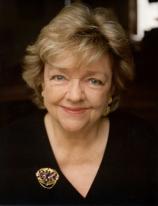Chestnut Street
Review
Chestnut Street
Chestnut Street was a lovely place to play because it was shaped like a horseshoe and there was a big bit of grass in the middle beside some chestnut trees. Some of the people who lived there went to great trouble to keep it looking nice. Others just sat there at night and drank lager and left the cans.
Maeve Binchy has given us many glimpses into Irish lives over several decades, with such wonderful books as CIRCLE OF FRIENDS, FIREFLY SUMMER, TARA ROAD and QUENTINS. She put pen to paper, and a character simply took shape. Upon occasion over the years, when the inspiration hit her, she wrote the story of a person she imagined living on her Chestnut Street, a tidy semicircle of a lane in Dublin where the houses are modest yet enviable. She created an entire neighborhood of residents, past and present, and now we have the great opportunity to meet them. Here are just a few.
"The ways in which these infidelities are dealt with on Chestnut Street range from very clever to downright sad.... And thankfully, Maeve Binchy’s touch is apparent in each and every story. She will be sorely missed in the world of storytelling.
At Number 11 Chestnut Street lives a most decent man called Bucket Maguire. He has a ne’er-do-well son named Eddie who visits now and then, and who the neighbors all despise. Bucket loves Eddie unconditionally, making excuses for the trouble he gets into and all of the bad things that happen around him. Bucket is a simple man, and his fathering skills do Eddie no favors. But his final gesture may be the one that saves his son.
And then there’s young Nessa Byrne, whose Aunt Elizabeth moved off to America a long time ago, but she knows exactly what matters most in life. She comes to Chestnut Street once a year to visit. Impressions make all the difference, she says. For instance, it would be far better for Nessa to call herself by her full name, Vanessa, and create a more respectable image of herself through her surroundings and clothing. That’s all that matters: the image. During her visits, Aunt Elizabeth teaches Nessa an invaluable lesson, only it may not be the one she thought she was teaching her.
There’s a fat fellow, Norman --- an actor, actually --- who has just moved onto Chestnut Street. His friends wish to set him up with a model, Joyce. They plan for them all to meet up at a Greek restaurant. Joyce hates Greek food: “It all looked like goat’s balls to her and the wine people drank with it seemed to taste like paint remover.” When the day arrives, Norman puts on a stubborn act and refuses to go, only changing his mind at the last moment. He thinks models are too self-involved, while Joyce thinks blind dates are a bore, and she would only be doing the poor fellow a favor. When they do get together, their interaction is priceless.
There are another couple dozen characters --- some old, some young, some happy, some not so much. Several of the street’s occupants have endured a cheating spouse, probably because many of the stories were written before the referendum on divorce. Wandering became the option of choice once you had fallen out of love with your husband or wife. The ways in which these infidelities are dealt with on Chestnut Street range from very clever to downright sad. But here, life’s problems, blessings, landmarks and tragedies all happen in many and varied ways. And thankfully, Maeve Binchy’s touch is apparent in each and every story. She will be sorely missed in the world of storytelling.
Reviewed by Kate Ayers on April 25, 2014
Chestnut Street
- Publication Date: April 22, 2014
- Hardcover: 384 pages
- Publisher: Knopf
- ISBN-10: 0385351852
- ISBN-13: 9780385351850





